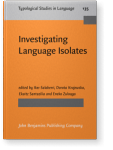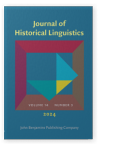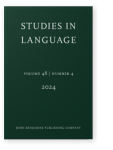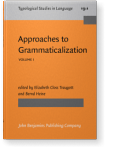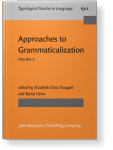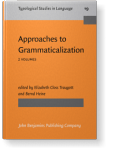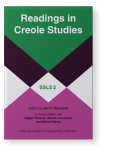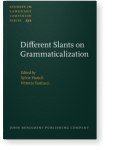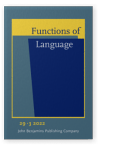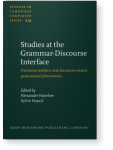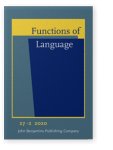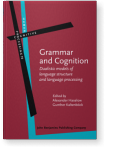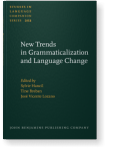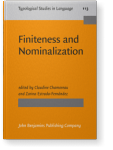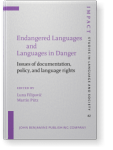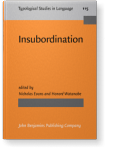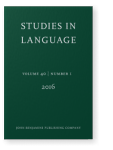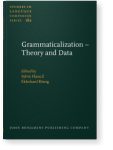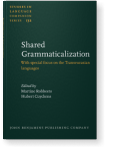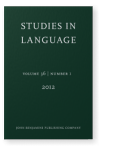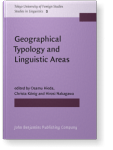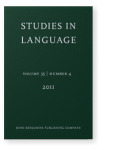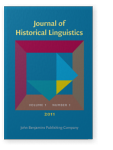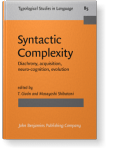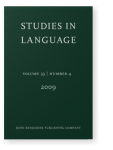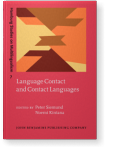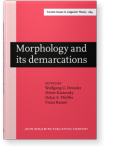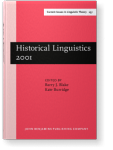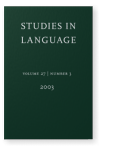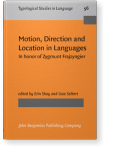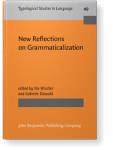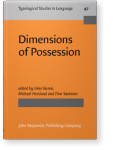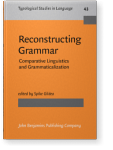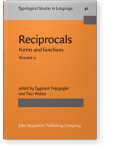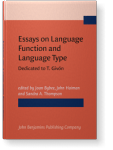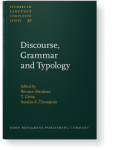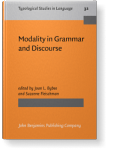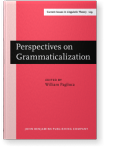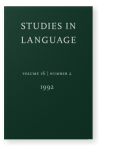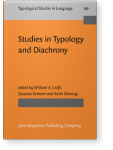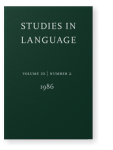Bernd Heine
List of John Benjamins publications for which Bernd Heine plays a role.
Book series
Journals
ISSN 2210-2116 | E-ISSN 2210-2124
ISSN 0378-4177 | E-ISSN 1569-9978
Approaches to Grammaticalization: Volume I. Theoretical and methodological issues
Edited by Elizabeth Closs Traugott and Bernd Heine
[Typological Studies in Language, 19:1] 1991. xii, 360 pp.
Subjects Morphology | Pragmatics | Syntax | Theoretical linguistics | Typology
Approaches to Grammaticalization: Volume II. Types of grammatical markers
Edited by Elizabeth Closs Traugott and Bernd Heine
[Typological Studies in Language, 19:2] 1991. xii, 558 pp.
Subjects Morphology | Pragmatics | Syntax | Theoretical linguistics | Typology
Approaches to Grammaticalization: 2 Volumes (set)
Edited by Elizabeth Closs Traugott and Bernd Heine
[Typological Studies in Language, 19:S] 1990. xii, 360 pp. + xii, 560 pp.
Subjects Morphology | Pragmatics | Syntax | Theoretical linguistics | Typology
Readings in Creole Studies
Edited by Ian F. Hancock
[Studies in the Sciences of Language Series, 2] 1979. xiv, 352 pp.
Subjects Contact Linguistics | Creole studies | Theoretical linguistics
2023 Chapter 9. On the grammaticalization of ideophones Different Slants on Grammaticalization, Hancil, Sylvie and Vittorio Tantucci (eds.), pp. 237–262 | Chapter
Ideophones, like English bang or thud, are interactive expressions used as vivid depictions of sensory imagery of states, events, objects, or qualities (cf. Dingemanse 2011, 2012, 2018; Dingemanse & Akita 2017; Andrason 2020, 2021). They are claimed to represent a universal class of linguistic… read more
2021 Chapter 1. On the rise of discourse markers Studies at the Grammar-Discourse Interface: Discourse markers and discourse-related grammatical phenomena, Haselow, Alexander and Sylvie Hancil (eds.), pp. 23–56 | Chapter
Discourse markers exhibit a range of grammatical properties that set them apart from many other lexical and grammatical forms. A number of hypotheses have been proposed to account for these properties. Most commonly, such accounts have drawn on grammaticalization theory, less commonly also on the… read more
2020 On the status of wh-exclamatives in English Functions of Language 27:2, pp. 207–233 | Article
Exclamative expressions like What an enormous crowd came! and How wonderful this journey is! have been described as forming one of the four basic sentence (or clause) types of English. The present paper discusses the main features of this type and analyzes them with reference to the framework of… read more
2020 Chapter 2. Dual process frameworks on reasoning and linguistic discourse: A comparison Grammar and Cognition: Dualistic models of language structure and language processing, Haselow, Alexander and Gunther Kaltenböck (eds.), pp. 59–89 | Chapter
The objective of the present paper is to compare two kinds of research traditions that developed in the course of the last decades to understand mental and linguistic processing. One tradition relies on the perspective and methodology commonly used in social psychology, cognitive psychology and… read more
2018 Are there two different ways of approaching grammaticalization? New Trends in Grammaticalization and Language Change, Hancil, Sylvie, Tine Breban and José Vicente Lozano (eds.), pp. 23–54 | Chapter
Grammaticalization as a framework of linguistic analysis developed a fairly stable format in the course of the 1980s and 1990s (Lehmann 1982; Heine & Reh 1984; Traugott & Heine 1991a, 1991b; Heine et al. 1991; Hopper & Traugott 1993; Bybee et al. 1994; Haspelmath 1999). Around the turn of the… read more
2016 On non-finiteness and canonical imperatives Finiteness and Nominalization, Chamoreau, Claudine and Zarina Estrada-Fernández (eds.), pp. 243–268 | Article
Imperatives exhibit cross-linguistically a wide range of structures, which makes it difficult to generalize about them or to propose a structural definition that would apply to all or at least to most of them. This article is concerned with canonical imperatives, that is, information units that… read more
2016 Extra-clausal constituents and language contact: The case of discourse markers Outside the Clause: Form and function of extra-clausal constituents, Kaltenböck, Gunther, Evelien Keizer and Arne Lohmann (eds.), pp. 243–272 | Article
Extra-clausal constituents as proposed by Dik (1997: 379–407) are linguistic elements that are typically marked off from the clause proper by breaks or pause-like inflections in their prosodic contour, or occur on their own, they can only be understood in terms of pragmatic rules and principles and… read more
2016 Reacting to language endangerment: The Akie of north-central Tanzania Endangered Languages and Languages in Danger: Issues of documentation, policy, and language rights, Filipović, Luna and Martin Pütz (eds.), pp. 313–333 | Article
Language endangerment in Africa is of a different kind than it is in many other parts of the world. Globalization and the impact of languages such as English, French, or Portuguese are not a major problem for the maintenance of African languages. Language loss is no less a factor in Africa than it… read more
2016 Chapter 2. On insubordination and cooptation Insubordination, Evans, Nicholas and Honoré Watanabe (eds.), pp. 39–64 | Article
The chapter is concerned more generally with what, following Evans (2007), we call insubordinated (or insubordinate) clauses, that is, with the conventionalized main clause use of what, prima facie, appear to be formally subordinate clauses. Insubordinated clauses are, as we argue here, information… read more
2016 Constructional change vs. grammaticalization: From compounding to derivation Studies in Language 40:1, pp. 137–175 | Article
Building on recent findings made in the framework of Construction Grammar, on the one hand, and within the framework on grammaticalization, on the other, the present paper is concerned with the development from lexical compounding to derivation. Compounding is presumably the most common source of… read more
2014 Explaining language structure: On categorial misbehavior in Walman (Papua New Guinea) Grammaticalization – Theory and Data, Hancil, Sylvie and Ekkehard König (eds.), pp. 67–86 | Article
Typically, certain grammatical features are associated with one particular lexical category rather than some other category. Nouns can be modified by numerals or adjectives, can take determiners like demonstratives or possessive attributes, can be inflected for number, case, etc. Verbs, by… read more
2013 Chapter 4. Contact-induced replication: Some diagnostics Shared Grammaticalization: With special focus on the Transeurasian languages, Robbeets, Martine and Hubert Cuyckens (eds.), pp. 67–100 | Chapter
That contact between genetically unrelated languages (or dialects) has taken place is relatively easy to establish when they share, for instance, sufficient lexical or grammatical forms. This is usually much more difficult to demonstrate when the shared elements concern structure and/or meaning,… read more
2013 On the origin of Grammar New Perspectives on the Origins of Language, Lefebvre, Claire, Bernard Comrie and Henri Cohen (eds.), pp. 379–406 | Article
The goals of the present chapter are twofold. On the one hand, it aims to show the potential that studies on grammaticalization offer for reconstructing earlier phases in the evolution of language or languages, that is, phases that are not within the scope of the classical methods of historical… read more
2012 Review of Nørgård-Sørensen, Heltoft & Schøsler (2011): Connecting grammaticalisation Studies in Language 36:1, pp. 202–207 | Review
2011 Areas of Grammaticalization and Geographical Typology Geographical Typology and Linguistic Areas: With special reference to Africa, Hieda, Osamu, Christa König and Hiroshi Nakagawa (eds.), pp. 41–66 | Article
2011 On thetical grammar Studies in Language 35:4, pp. 852–897 | Article
Most frameworks of linguistic analysis tend to highlight phenomena of language use and/or language knowledge such as sentence and word structure, while backgrounding or ignoring other phenomena that are interpreted as being of more marginal interest for the linguist. The main goal of this paper is… read more
2011 On predicting contact-induced grammatical change: Evidence from Slavic languages Journal of Historical Linguistics 1:1, pp. 48–76 | Article
For good reasons, linguists are highly skeptical when it comes to predicting linguistic change. As has been argued in Heine (2003: 598–599), based on observations on some regularities of grammatical change made within the framework of grammaticalization theory, however, it seems possible to… read more
2009 From nominal to clausal morphosyntax: Complexity via expansion Syntactic Complexity: Diachrony, acquisition, neuro-cognition, evolution, Givón, T. and Masayoshi Shibatani (eds.), pp. 23–52 | Article
The study of the rise of syntactic complexity, in particular of clause subordination and recursive language structures has more recently become the topic of intense discussion. The present paper builds on the reconstruction of grammatical evolution as proposed in Heine and Kuteva (2007) to present… read more
2008 Contact-induced word order change without word order change Language Contact and Contact Languages, Siemund, Peter and Noemi Kintana (eds.), pp. 33–60 | Article
2005 Grammatical Hybrids: Between Serialization, Compounding and Derivation in !Xun (North Khoisan) Morphology and its demarcations: Selected papers from the 11th Morphology meeting, Vienna, February 2004, Dressler, Wolfgang U., Dieter Kastovsky, Oskar E. Pfeiffer and Franz Rainer (eds.), pp. 81–96 | Article
2003
On degrammaticalization
Historical Linguistics 2001: Selected papers from the 15th International Conference on Historical Linguistics, Melbourne, 13–17 August 2001, Blake, Barry J. and Kate Burridge (eds.), pp. 163–179 | Article2003 On contact-induced grammaticalization Studies in Language 27:3, pp. 529–572 | Article
Grammaticalization is based on universal strategies of conceptual transfer. Contact-induced language change on the other hand is an areally confined process resulting from specific historical events. What this suggests is that the two constitute quite divergent phenomena and, in fact, in the… read more
2003 Location and motion in !Xun (Namibia) Motion, Direction and Location in Languages: In honor of Zygmunt Frajzyngier, Shay, Erin and Uwe Seibert (eds.), pp. 129–150 | Article
2002 On the role of context in grammaticalization New Reflections on Grammaticalization, Wischer, Ilse and Gabriele Diewald (eds.), pp. 83–101 | Article
2001 16. Ways of explaining possession Dimensions of Possession, Baron, Irène, Michael Herslund and Finn Sørensen (eds.), pp. 311–328 | Chapter
2000 Grammaticalization chains across languages: An example from Khoisan Reconstructing Grammar: Comparative Linguistics and Grammaticalization, Gildea, Spike (ed.), pp. 177–200 | Article
2000 Polysemy involving reflexive and reciprocal markers in African languages Reciprocals: Forms and functions, Frajzyngier, Zygmunt and Traci Walker (eds.), pp. 1–30 | Article
1997 On Attributive Possession in Kabiye Essays on Language Function and Language Type: Dedicated to T. Givón, Bybee, Joan L., John Haiman and Sandra A. Thompson (eds.), pp. 217–230 | Article
1995 On the German werden Future Discourse, Grammar and Typology: Papers in honor of John W.M. Verhaar, Abraham, Werner, T. Givón and Sandra A. Thompson (eds.), pp. 119–138 | Article
1995 Agent-Oriented vs. Epistemic Modality: Some Observations on German Modals Modality in Grammar and Discourse, Bybee, Joan L. and Suzanne Fleischman (eds.), pp. 17–54 | Article
1994 Grammaticalization as an explanatory parameter Perspectives on Grammaticalization, Pagliuca, William (ed.), pp. 255–287 | Article
1994 Areal influence on grammaticalization Language Contact and Language Conflict, Pütz, Martin (ed.), pp. 55–68 | Article
1992 Grammaticalization Chains Studies in Language 16:2, pp. 335–368 | Article
Recent studies in grammaticalization suggest that the development of grammatical categories is the result of an interaction between cognitive and pragmatic operations, and that this development may lead to the rise of continuous linguistic structures which have been referred to as… read more
1991 From cognition to grammar: Evidence from African languages Approaches to Grammaticalization: Volume I. Theoretical and methodological issues, Traugott, Elizabeth Closs and Bernd Heine (eds.), pp. 149–188 | Article
1991 Introduction Approaches to Grammaticalization: Volume I. Theoretical and methodological issues, Traugott, Elizabeth Closs and Bernd Heine (eds.), pp. 1–14 | Article
1991 Introduction Approaches to Grammaticalization: Volume II. Types of grammatical markers, Traugott, Elizabeth Closs and Bernd Heine (eds.), pp. 1–14 | Article
1990 The dative in Ik and Kanuri Studies in Typology and Diachrony: Papers presented to Joseph H. Greenberg on his 75th birthday, Croft, William A., Suzanne Kemmer and Keith Denning (eds.), pp. 129–150 | Article
1986 On the Metaphorical Base of Grammar Studies in Language 10:2, pp. 297–335 | Article
1979 6. Some linguistic characteristics of African-based pidgins Readings in Creole Studies, Hancock, Ian F. (ed.), pp. 89–98 | Chapter
